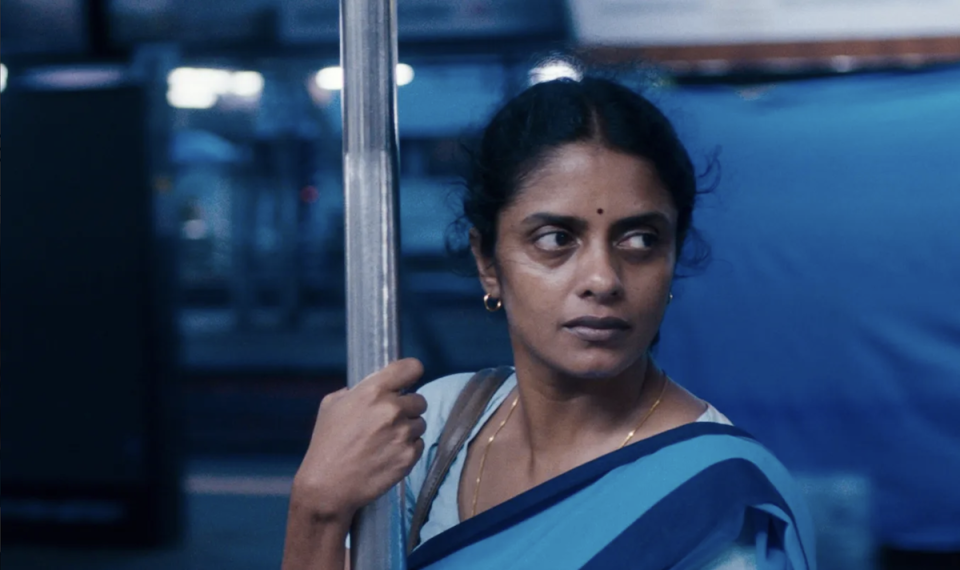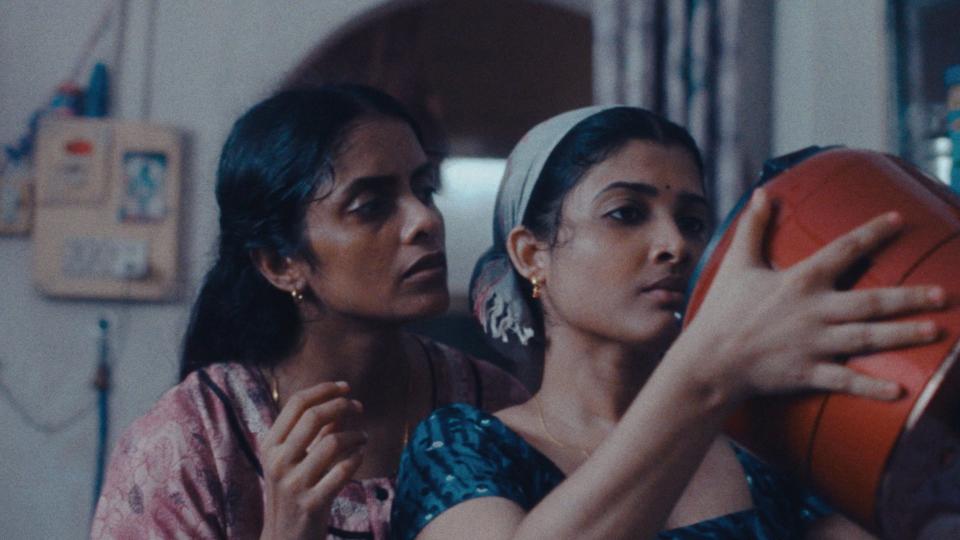‘All We Imagine as Light’ Lands on France’s Oscar Shortlist

“All We Imagine as Light” (November 15, Janus Films/Sideshow) is a film that is difficult to describe. You have to experience it. Indian documentarian and rookie scripted filmmaker Payal Kapadia tells the story of two Mali nurses in Mumbai, and shoots the city in a singular visual style. She has lived there, and understands its rhythms and colors. One veteran nurse (Kani Kusruti) is estranged from her husband from an arranged marriage. He’s living abroad, and she misses him. A mysterious package arrives, a rice maker. Is it from him? Her younger roommate (Divya Prabha) is enjoying a secret affair with a Muslim. Another older friend (Chhaya Kadam) is about to be evicted from her apartment. When the roommates help her move back to her home village, the movie shifts into another mode, and winds up somewhere unexpected.
I spoke to Kapadia on Zoom before festival screenings of her movie in both Telluride and Toronto, where it continued to build strong buzz after winning the Grand Prix at Cannes, the first Indian movie to ever earn the second-place prize. Its Metascore is currently 93.
More from IndieWire
How 'The Featherweight' Flawlessly Replicates the Look and Sound of the 1960s
As 'The Substance' Opens in Nearly 2,000 Theaters, a Wide Specialized Release Is Oxymoron No More
Kapadia has been fascinated by mixing fiction and non-fiction since film school. “Instead of being bound by these restrictions, it’s nicer to be freed by them,” she said. “When I was making the non-fiction film [2021’s “The Night of Knowing Nothing”], I had an element of fiction in it. The main narrative is a fictional character that tells the story of what’s happening in her life and all that is from archived footage, but the main story is fictional. So I was already interested in this device. When you’re making a film, everything seeps into one another.”
When Kapadia was writing the script, she knew that her film wasn’t story-driven. “It would be driven by the characters and the relationships between them,” she said. “And the city was like a character in the film. So these things were in my mind. It’s like cooking, you have to put a few things in and see how it goes. I enjoy this process a lot.”
She started with the idea of a working woman in Mumbai, “and what it feels like to come to Mumbai to work,” she said. “It’s a city that gives a lot of possibilities to women. It’s safer than some other parts of the country to work there as a woman. You can go home at night late, for example, the trains are quite safe. So there are those benefits, but it’s also a difficult life because it’s expensive and it’s not a very comfortable way to live your life there. All these questions that I had were the beginning point of the film, and I was somehow mesmerized by this image of the rice cooker. We have a lot of advertising of how these kitchen products are so sensual, as if it’s going to change your life. I was drawn to this kitchen appliance being almost something sexy.”
The movie portrays women in a sensuous, intimate way. It’s a celebration of the feminine. “For me, it was normal to have a film where there were so many female characters,” she said, “and I feel something strongly towards the female friendship and the sort of companionship that has helped me a lot in my life. So it was something that I felt affectionate towards, but it’s also complicated and never easy. I was interested in these different layers of femininity in the country. The film starts with a very old woman and ends with a very young girl who has short hair and could be confused to be a boy. And all these women could be at different times the same person.”

For “All We Imagine as Light,” Kapadia and her crew wandered around Mumbai location scouting and shot what they saw. “There was so much of the city that I wanted to keep as it was, and as we met people, we wanted to have more interviews,” she said. “It started becoming like a non-fiction piece inside the fiction piece. And for me, the two juxtaposed together bring out another truth, perhaps, which makes the fiction also more truthful.”
She’s known Mumbai all her life. “It’s a city that I keep leaving and coming back to,” she said. “When that happens, you notice more the nuances of a city. Because if you’re living in the same place for a long time, you tend to not always notice everything. But because I was going out and coming back a lot, I noticed the mise-en-scene of the city.”
Mumbai has been shot in many films, from “Salaam Bombay” to “Slumdog Millionaire,” but it has never looked like this. The filmmakers filmed the city with monsoon colors. “Because in Mumbai we only have two seasons,” Kapadia said. “One is the monsoon and one is not monsoon. So we started looking at the colors that the city gives us, which is this blue color, and the whole city gets covered in bright blue plastic sheets, no matter how rich you or poor you are the rain comes down on you, and you need to cover your windows. So blue became like a color of the monsoon that me and my cameraman got really into, and we started designing all the scenes around this and the wet monsoon feeling, because the rain also has a double contradiction.”
In Indian films, rain is sometimes represented as “this beautiful, romantic time where lovers go out in the rain,” said Kapadia. “But if you actually live in Mumbai, it’s a pretty terrible time. Normally it should start around mid-June, and it goes on until late September. That’s a long time, but in July and August, the rain is horrible. It’s the time where Mumbai can get covered in water, and it’s difficult for people to get to work and trains stop and schools stop.”

For her first long-form narrative film with actors, Kapadia chose two veteran Mali actresses. “They are quite well-known in the art house cinema circuit in Kerala in the South,” she said. “They do quite a few films that travel to festivals, but also get shown in the country. Not big films, but interesting scripts. So I had already seen their work.”
The actors rehearsed all the scenes before shooting, living together for a month, “like a theater play,” said Kapadia. “And we also shot that with my cameraman. So I have this funny film from our kitchen and our bedroom, where we did all the scenes in different ways, gestures, expressions, feelings. And it was by watching and re-watching and discussing those things that we came up with the language of the film. Of course, there was improvisation on the set.”
Kapadia was also contrasting hectic city life with the more relaxed countryside. “It was more to do with the feeling of time,” she said. “Because when we are in the city, there is a different sense of time. There’s no time to reflect or think about life in this way, because there is too much work to be done. So this trip gives a moment of time which is not the same as the time we felt in the city. And that’s why even the film slows down in this part, where you feel the sense of the passage of time and that makes her reflect on the choices she’s made. Sometimes you need to get out of your immediate surroundings to be able to think fundamentally about yourself. The intention was to get out of this constricted city feeling of everybody being stuck with each other, into something that was more vast and horizontal, and it allows for certain feelings to unfold.”
Some magic realism creeps into the story when they get to the rural setting. “In Indian folk stories, or tales of women,” said Kapadia, “oftentimes nature plays an interesting role. And your husband can become a ghost. Or he can become a tree, or he can become a dog. These things happen because you can’t talk about certain things in our culture, right? So this is a way.”
In the world of Indian cinema, Kapadia’s films are strictly independent, outside the mainstream industry. She raised funds through multiple territories including France, which has shortlisted the film for the Oscar. This forced her to go through the process of explaining her film to multiple parties. “It was a learning process,” she said, “because you meet many people along the way, and they have a structural approach to how to make a film. So at different stages at the filmmaking process, you’re always talking to people about what you’re doing. Filmmaking when you’re writing can be lonely. So I enjoyed the process, even though it took a bit of time. It was still valuable.”
Kapadia harbors Oscar hopes mainly because it might get her film seen by more people. “Getting the recognition in Cannes has helped to put it in the minds of people,” she said. “So I hope that they do consider it. And we also have a distribution company in India, which is really nice, because I’ve never had my films distributed in this way. So I hope that that helps.” India’s Oscar selection committee has a tendency to overlook independents like “The Lunch Box” and “RRR.” The film opens in India in November, at the same time as the U.S.
Next up: Kapadia is writing another film, which is also based in Mumbai. “It will take a few years to do; it’s just begun,” she said.
Best of IndieWire
2023 Emmy Predictions: Who Will Win at the Primetime Emmy Awards?
2023 Emmy Predictions: Outstanding Documentary or Nonfiction Special
2023 Emmy Predictions: Outstanding Documentary or Nonfiction Series
Sign up for Indiewire's Newsletter. For the latest news, follow us on Facebook, Twitter, and Instagram.
